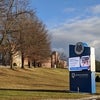The Final Whistle? | Future of struggling Milford-based United States Basketball League's uncertain
The nation’s only publicly traded professional basketball league — Milford-based United States Basketball League — is now throwing air balls after a 22-year history of launching the professional careers of some of the biggest names in basketball. Financially stumbling, the minor league recently cancelled its entire 2008 season for its seven franchised teams.
Listed on the OTC Bulletin Board, the league’s recent season cancellation marks the close of a tumultuous 12-month period. The league celebrated the opening of its new corporate headquarters, saw its shares rise to a high of $1.57 this year, and then fall 74 percent to its current low of 41 cents as of press time. The stock’s five-year high was reached in April 2005 when it traded at $2.25 per share.
On Jan. 11, the league also announced that it would be unable to file its next quarterly filing as required by the U.S. Securities and Exchange Commission.
According to a posting on the league’s Web site, the purpose of its season cancellation is to develop growth strategies.
Notably, USBL chairman and commissioner Daniel Meisenheimer III has not responded to several requests for an interview.
Launching Pad
For more than two decades, the USBL has billed itself as a “League of Opportunity” for players with NBA aspirations. About 150 National Basketball Association players, including Spud Webb, Avery Johnson, Manute Bol and Mugsey Bogues have used the USBL as a launching pad for a career in professional sports. The league also once touted Kareem Abdul-Jabbar as a coach.
But its current money woes overshadow its past successes. Within three months, the USBL’s press releases indicated a turnaround, from announcing its new corporate headquarters at 183 Plains Rd. in Milford to the cancellation of its 2008 season.
Part of the league’s plan to reduce its debt was to sell its former headquarters. However, according to town records, the property has not been sold yet.
According to the company’s financial filings, as of Aug. 31, the company had $1,213 in cash and a $1.08 million working capital deficit.
The most damaging aspect of the August filing revealed the USBL needed $300,000 in working capital to sustain a season and it could barely raise $200,000. Among its troubles, advertising and sponsorship revenues dropped from $57,500 in 2006 to zero in 2007.
The league’s roller coaster ride continued, when the USBL announced that it would be advertising in several newspapers and magazines, including the Wall Street Journal, to attract investors.
Seemingly, the ads paid off. By November, the league was trumpeting a “significant amount of interest” from the ads. Meisenheimer stated in a press release that the league was in discussion with 12 interested parties for expansion teams. The interest did not translate into investments.
“Given the company’s current financial condition, the ability of the company to raise additional capital other than from affiliates is questionable,” its filing stated. “At the current time, the company has no definitive plan as to how to raise additional capital.”
The USBL’s latest move has been to retain the services of Colebrooke Capital, a New York-based investment company, to explore ways to restructure.
Investment analysts have predicted the stock will drop even lower in 2008 as the forecast becomes bleaker.
One factor affecting USBL’s decline has been the NBA’s establishment of its own developmental league, the D-League. That move also ended the USBL’s hopes to create a relationship with the NBA to develop players.
The USBL’s 2007 season also signaled trouble when it began with 10 teams, but ended with just four.









0 Comments